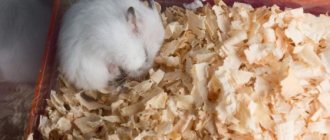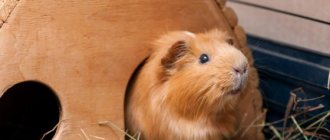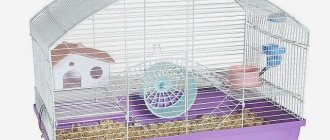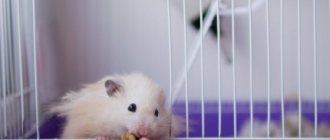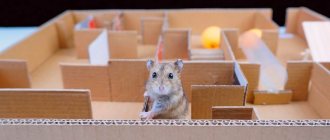What materials can you use to make a hamster house?
To make your furry pet feel comfortable and safe in a homemade home, it is made from environmentally friendly materials, because he is a rodent and is used to trying everything by heart. For the house, choose cardboard, paper, plywood, wood or food-grade plastic. Its dimensions depend on the size of the hamster. What are the housing options?
You can make a house for a hamster with your own hands from almost any materials.
From a plastic container
For such a house you need a food-grade plastic container of the appropriate size (optionally: 640*460*300), a construction grid, a marker, a ruler, a pencil, a knife, a lighter and plastic clamps. You need to cut an entrance hole in the lid of the container using a knife heated with a lighter. It is easy to secure the mesh with plastic clamps, making holes for them with a hot knife. A simple house for a hamster is ready.
From plastic bottles
Such a house can even replace an entire cage - in this case you need at least three five-liter water bottles. The necks of the bottles are cut off at the widest part, and a threaded ring is made from the caps. The upper parts of the containers are cut off, and holes are made 3–5 cm from the base into which the cut necks and rings are tightly inserted (in the form of a tunnel from one container to another). This is how three bottles are connected. One of them is a bedroom for a hamster, in which a “mink” is placed (from Lego or other material), the second is a dining room, and the third is a toilet, the fourth container is used as a playroom, where a wheel for a hamster is placed. The reliability of fastening the parts of the house is ensured using tape and superglue.
From coconut shell
You need to make a hole in the coconut, drain the milk, and mark the entrance for the hamster. A hole with a diameter of 5 cm is drilled, and the pulp is removed from the fruit with a chisel. To make this process easier, you can put it in the freezer overnight. After removing the internal contents, the coconut is washed and the edges of the entrance are sanded. The finished house is placed in a cage.
From cardboard tubes
This is the simplest version of a hamster house; it is suitable for miniature rodents. Use 2 tubes from toilet paper rolls or paper kitchen towels. One of them is flattened and semicircular segments are cut out on both sides, and the same is done with the second tube. After straightening, they are inserted into one another crosswise. It turns out to be a mini-labyrinth.
Hamster feels cozy in a house made of cardboard tubes
From wooden sticks
This design requires 80-120 wooden popsicle sticks, wood glue, a knife and a ruler. A preliminary drawing of two side walls, a floor, a ceiling and two roof parts is made. From sticks glued in parallel, all the necessary details of the house are repeated. Glue the walls, ceiling and floor together. You can decorate the joints with the same sticks.
The rafters of the roof of the hamster house (for rigidity) are made by placing the sticks first along and then across. Until the glue dries, you can “secure” parts of the structure with rubber bands. If desired, the house can be two-story or higher. It is not difficult to attach a ladder of the same sticks to the front.
We have listed the most popular options for making a house for rodents in separate subsections below and described them in more detail.
How to make a coconut house - video
From plywood
For construction you need:
- plywood sheet;
- ruler;
- a simple pencil;
- circular saw or jigsaw;
- sandpaper;
- hammer;
- small nails.
Markings are made on a plywood sheet with a pencil. For a small animal, a back and front wall with a height of 10 cm and a width of 15 cm is suitable. The side walls are 10x10. There is no need to do the floor. A roof of 17x12 cm is sufficient. In addition to the entrance, windows are cut out that will serve as additional ventilation.
First of all, all parts of the house are processed with a file and cleaned with sandpaper. Particular attention should be paid to the entrance and ventilation openings.
All walls are connected to each other with nails. The roof is placed on top, but not nailed down, this will make cleaning the home easier.
In this video you can see an example of such a construction.
From paper
This house turns out to be small and suitable for small individuals.
For the design you will need:
- toilet paper;
- container with water;
- balloon.
- The balloon is inflated to a small size.
- Toilet paper soaked in water is applied to it in at least 8 layers.
- The fastest way to dry a house is with a battery.
- In the already dry structure, the ball is pierced and removed.
- The entrance is cut out and the house is ready.
ATTENTION! A paper shelter will not last long; sometimes hamsters will destroy it in one night. The advantages are that they are fast, simple and inexpensive.
From an old plastic toy
Houses of this type are rare, but in vain. If the size of an unnecessary toy fits in the cage, does not create any inconvenience for the hamster and he feels comfortable in it, then this is an excellent option.
Depending on the thickness of the plastic, you should use a soldering iron or scissors will suffice.
The entrance and ventilation windows are made with the necessary tools, and bedding is laid on the “floor”.
An unusual home for a pet is ready.
From Lego
Construction from Lego is limited only by the imagination of the breeder. From this material you can assemble fancy rooms and labyrinths. Bright details will be a nice addition.
When constructing a shelter, it is necessary to tightly fasten the parts so that the hamsters do not take them apart. It is not recommended to use small elements.
The floor is also covered with bedding.
The video shows one example of a house made from Lego.
From a toothbrush holder
If you suddenly have a stand for toothbrushes lying around the house, then you can safely use it as a house for a rodent. It usually already has all the necessary holes, but such a housing is suitable only for dwarf hamsters.
From plastic containers for cereals
Often, jars for cereals have holes on the lids that will act as an entrance and the necessary ventilation. If they are not there, then the cover can simply be removed.
In order for the container to turn into a dwelling, it must be placed on its side and the floor covered with bedding.
Square-shaped jars are better suited for this purpose; they are more stable.
From glass jars
The container is placed on its side, and its neck becomes a spacious entrance to the pet’s shelter. It is better to use those that have edges; such jars are more stable.
The advantages of a glass house are that they are durable and easy to clean.
Minuses:
- Hamsters will most likely feel unsafe in a transparent house. Therefore, the home must first be painted or wallpapered;
- glass is a slippery and cold material. To prevent this from causing inconvenience to the rodent, the floor of the house is covered with a dense layer of sawdust or other bedding. To prevent the litter from bunching up, the surface where it will be located is smeared with glue and sprinkled with sand.
DIY wooden house for a hamster
The most interesting and reliable design is a wooden house. You can also make a fence by placing a multi-room mansion behind it. It is easier to use plywood for these purposes, but wood is more beautiful and lasts longer. The wood is first treated with an antiseptic, then with stain, and to make cleaning the future room easier, it is also coated with furniture varnish. The principle of creating this house for a hamster is the same as that of a birdhouse.
Wood is the best material for making a house
Required tools and materials
The best option for making a house for a hamster is a 4 cm thick hardwood board; multi-layer plywood is also perfect. You also need a drill, sandpaper, small nails with a hammer or glue for wooden surfaces, a drill and a jigsaw.
Manufacturing instructions
- Mark the workpieces. For small hamsters, the front and back walls are made 15 by 10 cm, and the side walls - 10 by 10 cm, for the top you need 17 by 12 cm, then the roof will be slightly wider than the perimeter of the house.
- Cut out windows in front for entrance and ventilation of the home.
- To make it more convenient to fasten the parts together, nail narrow slats at the points of their connection.
- Sand each element of the house and clean the edges with sandpaper.
- Knock down the walls with nails or fasten with self-tapping screws. There is no need to fasten the roof to the frame for ease of cleaning.
- It is important that the points of the nails do not stick out inside the home. Kill them in a way that is safe for your hamster so that they don't hurt him.
How to make a cage for a dwarf with your own hands
First you need to choose the material. Only non-toxic and durable elements are allowed to be used. A house for the animal can be built from unpainted boards or plywood, plastic, coconut shells and even thick cardboard. It is important to remember that homemade cages made from natural elements are short-lived, since the hamster will constantly sharpen their upholstery and walls with his teeth.
How to make a reliable and safe cage: step by step processes.
The chosen material is plywood and boards. You will also need a metal mesh and plexiglass.
The necessary tools are a marker or felt-tip pen for markings, hot-melt adhesive and hot-melt gun, and a cutter.
We cut and sand 3 boards of the same size.
We drill a 5-6 cm hole in one of the boards.
We connect the resulting elements together. Coat it well with glue, keep it pressed tightly for 3-5 minutes.
We attach a metal mesh to the resulting sides from above.
Cover the remaining side with plexiglass (with hot-melt adhesive).
The fastening of parts and mesh is done strictly from the outside so that the dzhungarik does not get hurt on the protruding edges.
The design features of such a cage will allow you to freely observe your pet, and the mesh will provide a constant flow of fresh air.
Hamster house made of cardboard
It’s much easier to build a cardboard house for your furry friend with your own hands than a wooden one. But it will also serve much less, given the baby’s sharp teeth and habit of constantly gnawing on everything. Pasting with tape will add some rigidity to such a structure. You can print out a suitable template diagram for a hamster’s home on a color printer and, attaching it to a sheet of cardboard, cut out a blank using it. It needs to be bent in certain places, glue both parts and do not forget to cut an entrance for the hamster on the front surface. But there is another option.
Required tools and materials
A cardboard box of paper napkins of sufficient size, several cardboard tubes from toilet paper rolls or paper towels, scissors, PVA glue.
Manufacturing instructions
- Place the box on its side so that the hole for napkins is on the front surface.
- Attach several toilet paper rolls together in a cross pattern, as mentioned earlier.
- Insert one of these elements into the hole for napkins, and connect the others with it and with each other. The result will be a house with a labyrinth exit.
- Secure all connections with glue. The hamster house is ready.
Possible problems and ways to solve them
Hamster doesn't sleep in the house
Reasons why a hamster does not sleep in the house:
- the material or bedding causes allergies or is unpleasant for the pet;
- the animal did not understand the purpose (to eliminate the problem in this case, you can put an object with an already familiar smell in the house);
- the pet uses it to store food;
- the entrance to the house is inconvenient;
- the animal feels unsafe in it (transparent walls, large holes);
- no ventilation;
- closely;
- doesn’t want to (in this case you just need to give him time to get used to it).
Hamster goes to the toilet in the house
Hamsters are very clean, but sometimes they start using their sleeping place to relieve themselves.
Ways to combat this habit:
- You can purchase a litter tray and accustom your pet to it from the first days of its arrival at home.
- Place the house in the cage on the tier above. The animal will intuitively go downstairs to the toilet.
- Place wet litter from the home in another corner, thereby showing that it will be more hygienic.
Assembling a hamster house with your own hands is much more interesting than buying it in a store. The main thing is a little patience and a bit of imagination. The pet will be very happy. And the original home will delight the breeder with its appearance.
Sources:
https://zoolog.guru/domashnie-zhivotnye/gryzuny/domik-dlya-homyaka-svoimi-rukami.html?sign=30781133083998%2C878843990401894
https://pets2.me/bok/1378-kak-sdelat-i-obustroit-domik-dlya-homyachka-svoimi-rukami.html
https://zverek.org/domiki-dlya-homyakov.html
Features of buildings for Dzungarian and Syrian breeds
The sizes of houses for Syrian and Djungarian hamsters should be different
Each hamster house should be designed taking into account the size and habits of your furry pet. It is important that the active and nimble dwarfs have the opportunity to play; the rodents should be comfortable and safe in the house. Djungarian or Syrian hamsters need material to build a nest; it must be soft and environmentally friendly. It can be cotton wool, napkins, but not newspaper - the lead alloy for casting typographic fonts is dangerous for animals.
It is also necessary to take into account that small animals can escape from the house through cracks caused by poor-quality fastening of parts during manufacturing; chew a hole, finding its weak point. And larger Syrian hamsters can get stuck in a tunnel opening that is too narrow, which can be very frightening for them. Therefore, you need to take into account all the little things and constantly check your home.
How do hamsters like to sleep?
Rodents love to sleep in small shelters: burrows, hollows, nests - sleeping in a small space is familiar and natural for these animals. Small rooms provide the animal with the necessary thermoregulation and a feeling of comfort.
Different models of hamster houses satisfy the needs of pets and the aesthetic needs of owners. Design ideas allow you to turn your pet's sleeping place into a cage decoration. A house for a dwarf and a Syrian hamster can be made from:
- ceramics;
- fabrics;
- plastic;
- wood;
- vines;
- plant fibers.
The accessory is inexpensive, but you might be more interested in making a hamster house with your own hands.
Home accessories
In order for the rodent to like the house and for the baby to grow up healthy and active in it, the housing needs to be filled with suitable accessories..
Educational toys for hamster
- Running wheel. Its dimensions depend on the size of the rodent: for the Djungarian it is a twenty-centimeter toy, for large specimens, including Syrian ones, up to 30 cm. The path on it must be continuous; it is not permissible to use a mesh for this, which can cause injury. It is important to know that hamsters like to stay awake at night, so the toy should be silent.
- Tunnels. They should be spacious and well ventilated.
- Hammocks for a hamster made from tubes of different diameters or a swing in the form of four posts, a crossbar and a perch for sitting.
- Wooden bridges or other objects for developing hamster teeth. It is good to use mineral stones and crayons. Cardboard boxes, toilet paper rolls, and branches of fruit trees are also suitable for these purposes.
- A walking ball made of safe plastic in different colors with ventilation holes and recesses for the paws.
Drinking and eating facilities
It is very important to choose the right feeder and water bowl for your rodent.
There must be a special drinking bowl in the house for drinking. You can make it yourself or use a bowl, which should be covered so that food or parts of the bedding do not fall into it. Small species of hamsters like to dig up pieces of food, so you can put them in the bedding. Large specimens require a stable food bowl that is difficult to tip over.
It is better to provide 2 containers - one for wet food and the other for dry food. Typically, rodents like to sit in the feeder, so it should be spacious enough. It is also important that there is a separate “pantry” for supplies that the hamster will definitely make. This could be a container in a secluded corner of the house. The hamster himself will “tell you” where his hiding place is, you just have to watch him carefully and then place a bowl there.
Hamster bedding
Bedding is very important for keeping the house clean and creating comfort and coziness. It can be pressed sawdust, but not too small so that it gets into the baby’s nose or gets tangled in his fur.
If wood pellets are used, they should be odorless and quickly turn into dust. Sawdust from coniferous trees can cause allergies in the animal, and fabrics and cotton wool are dangerous because they can tear into fibers in which the hamster can become entangled.
The best bedding materials for a hamster in a house are pieces of corn cobs with kernels, which can also be buried. Paper napkins or white unscented toilet paper are suitable for this.
The floor layer should be at least 6 cm deep, because hamsters love to play and burrow into it. When it gets colder, its thickness increases. It needs to be cleaned daily and changed once a week. A little granules from the previous bedding should be added to the fresh litter so that the familiar smell remains, otherwise the animal will become nervous.
Toilet
Hamsters are known for their cleanliness, so they need a separate place in the house for the toilet. You will have to clean it daily, removing waste and adding clean bedding. A cardboard tray is well suited for this purpose; this material is replaced quite often, because... it absorbs urine well, partially absorbing its odor.
The litter filler is often special clean sand, which the animal likes to rummage in, scattering it around. But sand does not hold odors well, so it needs to be changed often. Cat litter or mineral granules are not suitable for this - they can cause poisoning or allergies in your furry friend.
Sand bath
This is an important element of equipping a house for a hamster that does not like water treatments. They can be successfully replaced by bathing in special sand for chinchillas. To clean the fur from grease and dirt, place a high container with a ladder in the house. Let's assume an option with a hole cut in the side. It is closed on top with a lid that prevents the contents of the container from spilling out. The volume of the bath should be twice the size of the furry pet, and its sides should be high enough.
How to arrange a place for a hamster
How to make a house for a guinea pig - choosing material
“My home is my fortress,” this is how the hamster treats his home. The rodent spends a significant part of its life in the house, resting, hiding from “danger,” and hiding food for a “rainy day.” It is up to the owner to help arrange this secluded place for the pet by choosing the most convenient design, covering it with sawdust, shavings, soft rags or napkins.
Note! You can choose a suitable house for your hamster at any pet store. The main thing is to ensure that the materials from which it is made are environmentally friendly and odorless. Otherwise, the animal will simply ignore its apartment, and the owner will feel sorry for the money and effort spent.
Plastic pet house
Some inexperienced hamster owners are wondering what material they should choose for a house. Today, houses made of plastic, wood, and ceramics are offered for sale. You can buy a home made of fabric. There are no specific recommendations on this matter; each material has its own advantages and disadvantages.
Plastic house
A plastic house for a hamster is the most common and affordable option. As a rule, those models that are presented in pet stores are made from high-quality materials and do not pose a danger to the animal. The variety of designs can satisfy even the most demanding esthete. Plastic houses are easy to maintain. They are easy to wash and, in addition, dry quickly. The price for this plastic product starts from 140 rubles*
However, some experienced hamster breeders note some significant disadvantages of such a hamster home. First of all, such plastic houses have poor ventilation.
For your information! A rodent may accidentally swallow plastic if it wants to taste the house.
Wooden house
Wood is one of those materials that a hamster has to deal with in its natural habitat. Your pet will certainly like a wooden house, as it perfectly retains heat, reduces noise and allows air to pass through. As for the aesthetic side of hamster housing, in pet stores you can purchase both inexpensive models that resemble a miniature doghouse and real masterpieces of wooden architecture.
Wooden house for a pet rodent
However, wooden houses have significant disadvantages. First of all, this concerns care. Wood is not very convenient to wash. In addition, it takes quite a long time to dry.
Note! Many hamster owners refuse wooden houses, arguing that wood absorbs a specific odor that is not so easy to eliminate.
Ceramic house
Ceramic houses for hamsters appeared on the pet supply market quite recently, but have already managed to win fans. This is primarily due to the wide variety of design options. Hamster dwellings in the form of pumpkins, pieces of cheese, forest huts and stone grottoes can appeal not only to the hamsters themselves, but also to their owners. Especially if the pet's owners are children. In addition, ceramic houses are environmentally friendly and easy to maintain.
The disadvantages include the high cost of this product and the fragility of the design. Therefore, when sanitizing the cage, care should be taken to ensure that the cage does not fall.
Important! Unfortunately, after damage to a ceramic house, reuse is not permissible, since the glue used to glue the fragments together can be toxic to the pet.
House made of vines
Some species of hamsters, such as dwarf hamsters, like to live in a house made of wicker. It will not absorb odors, is excellently ventilated and, moreover, closely matches the natural conditions for a hamster.
Unfortunately, such houses can rarely be found on the shelves of pet stores, and they are expensive. In addition, over time, such a house can be significantly damaged by the occupant of the home. Some hamsters can sharpen their teeth on bars.
Wicker house for a hamster
Quilted houses made of fabric and padding polyester
Recently, houses for hamsters made of fabric and padding polyester have been gaining popularity. This is a good option because if it gets dirty, it can be easily washed and dried quickly. In such a home your pet will feel warm and comfortable.
Note! This option can either be bought at a pet store, or you can sew it yourself from scrap fabric scraps or disused shirts.
Housewarming: introducing your pet to its new home
A hamster, like any other pet, needs time to adapt to a new home and owner.
A newly acquired hamster, being in a state of stress, is afraid of everything. It will take him at least a week to gradually get used to the new house. During mastering, it is better not to disturb the baby. Once he gets comfortable, he begins to actively mark his territory, so you shouldn’t change the bedding at first.
Hamsters are inquisitive by nature, so sooner or later, if the baby does not feel danger, he will show interest in exploring the house and will definitely examine it.
It is important to toilet train young animals immediately. They themselves will designate a convenient place for it. By carefully observing the behavior of a new settler who has settled in, you can correct mistakes in the equipment of his house by making some rearrangements or improvements to suit his taste.
For example, when the playing wheel is poorly secured and makes sharp sounds when moving, the hamster gets scared and does not play in it. After strengthening, lubricating the axis of rotation or replacing it with a less noisy option, your furry friend will happily run and tumble.
What types of pet houses are there?
Thanks to the fact that today there are pet stores, you can find many different accessories for animals, especially rodents, including housing. They differ from each other in material of manufacture, size and purpose.
Wooden house
A wooden house for a hamster is an excellent option. Firstly, natural wood is used to make a home, and secondly, wood is a material that conducts air well, but at the same time retains heat. And this is very good, since hamsters are those who adore warm temperatures. Such a home is inexpensive and looks like a box.
Wooden dwellings come in different shapes. They can be:
- rectangular;
- oval;
- corner.
The shape itself is not important for your pet; you choose it based on the shape of your cage. You cannot take a large house and so that it completely fills the area of the cage, the rodent must always have a free corner so that it can run around or go to the toilet.
The downside of such a house is that rodents are rodents to taste absolutely everything. And it is precisely this object that will become the pet’s wooden housing, so over time it will be necessary to exchange it for a new housing.
Also, sometimes hamsters can go to the toilet at home and then wood is not a practical material, since it will be difficult to wash. But this is quite rare; hamsters are very clean people and usually go to the toilet outside the territory of their home.
Plastic house
These are the most popular types of housing for hamsters as they are practical and cheap. Plastic does not retain moisture and allows air to pass through well. Plastic material is much easier to clean from dirt and dries faster. A plastic house can be two-story, depending on your preferences.
But the disadvantage of such material is that they often use bad plastic to make such rooms and, in fact, they turn out to be quite toxic, because of this the animal will either not live at all, or it will significantly affect health and sometimes this may be fatal.
Also, as mentioned earlier, pets like to chew a lot, especially if it is plastic - it is very easy to chew it. Therefore, most likely, when you wake up one morning, you will not find the house, and again this will greatly affect the health of the pet.
Ceramic house
In fact, ceramic houses are one of the best options for hamsters. It’s easy to wash the material, and your pet won’t be able to chew it off, but such houses are quite rare and they cost a lot.
But sometimes there are problems such as the fact that ceramics do not allow air to pass through well and accumulate too much moisture inside, which can greatly affect the health of the pet. To prevent this from happening, you need to look for ceramic houses, such that there is an opening for entry and, as it were, a window for the hamster. This will make air circulation much better.
Pets are different and some will be able to gnaw off a kuramic dwelling, but others will not even touch it, but will peacefully snort there and hide food. By the way, under no circumstances throw anything out of the rodent’s home, as this will cause him anxiety and then he will refuse to sleep in it. Hamsters arrange their own homes, so first put the house in the cage so that your pet gets used to it. And then put hay inside, how much is difficult to say exactly, but half of the house should be covered with it.
Video: DIY hamster house
Before getting a hamster, you need to familiarize yourself with its habits using information materials. After all, this is not a living toy, but a creature with its own character, requiring care and attention. You should think about a house for a potential friend, about all the little details of equipping this home. The best options are to make it and some necessary accessories yourself from natural and safe materials. This will unite the family and allow everyone to participate in preparations for the arrival of its new member, and will help children (the usual instigators of acquiring a hamster) to feel responsible for the fate of their little friend.
House made of ceramics
In pet stores you can also pick up a house for a rodent made of ceramics. These models began to be produced relatively recently, but they are in demand. This material is non-toxic and absolutely safe for rodents. The house retains heat well, but its cost is several times higher than the options described above.
Reference. If you accidentally drop such a structure, it could very well break. Be careful when cleaning your pet's cage.
A special feature of such houses is the ability to create original designs, the colors are very diverse, and the sizes can also be different. You can find housing on store shelves made in the shape of fruits or vegetables; it looks very interesting.

